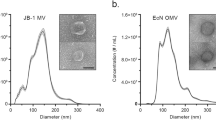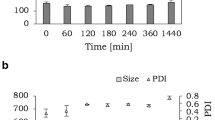Abstract
Purpose. To study the adhesion properties of charged liposomes to the healthy and inflamed (colitis-induced) rat intestinal epithelium.
Methods. Neutral, positively charged, and negatively charged liposomes were prepared and tagged. The cationic or anionic liposomes contained increasing amounts (13, 22, or 36 mol%) of either the cationic lipid dimethyl-dioctadecylammoniumbromide (DODAB) or the anionic lipid 1,2-dimyristoyl-sn-glycero-3-[phospho-rac-(1-glycerol)] (DSPG). Colitis was induced in rats by DNBS. Adhesion of the various types of liposomes was assessed in rat colon sacs. The effects of charge type, charge density (mol%), liposome size, and incubation time on the adhesion of the liposomes were compared in the inflamed and healthy epithelial tissues.
Results. Three times as many cationic liposomes adhered to the healthy colonic mucosa than neutral or anionic liposomes. However, anionic liposome adherence to the inflamed colonic mucosa was 2-fold that of either neutral or cationic liposomes (a finding that was verified by charged-dyes studies). Adherence was directly correlated with charge density. An inverse correlation was identified between cationic liposome size and healthy tissue adherence in short incubation periods. The adherence of cationic liposomes, which was also found to be time-dependent, decreased in healthy mucosa in the presence of high concentrations of aqueous Mg 2+ rinse.
Conclusions. Anionic liposomes could be useful for the topical delivery of anti-inflammatory drugs in inflammatory bowel disease therapy.
Similar content being viewed by others

References
L. A. Christensen. 5-Aminosalicylic acid containing drugs. Delivery, fate, and possible clinical implications in man. Dan. Med. Bull. 47:20-41 (2000).
P. Rutgeerts. The use of oral topically acting glucocorticosteroids in the treatment of inflammatory bowel disease. Mediators Inflamm. 7:137-140 (1998).
S. Ardizzone and G. B. Porro. Inflammatory bowel disease: new insights into pathogenesis and treatment. J. Intern. Med. 252:475-496 (2002).
K. P. Pavlick, F. S. Laroux, J. Fuseler, R. E. Wolf, L. Gray, J. Hoffman, and M. B. Grisham. Role of reactive metabolites of oxygen and nitrogen in inflammatory bowel disease. Free Radic. Biol. Med. 33:311-322 (2002).
S. Blau, R. Kohen, P. Bass, and A. Rubinstein. The effect of local treatment with cationized antioxidant enzymes on experimental colitis in the rat. Pharm. Res. 17:1077-1084 (2000).
A. Rubinstein, S. Blau, P. Bass, and R. Kohen. The effect of adhesive antioxidant enzymes on experimental colitis in the rat. In K. Park and R. J. Mrsny (eds.), Controlled Drug Delivery, Designing Technologies for the Future, vol 752. ACS, Washington DC, 2000 pp. 78-89.
S. Blau, N. Levin, B. Schwartz, and A. Rubinstein. Adsorption of cationized bovine serum albumin onto epithelial crypt fractions of therat colon. J. Pharm. Sci. 90:1516-1522 (2001).
C. J. Dunn, A. J. Wagstaff, C. M. Perry, G. L. Plosker, and K. L. Goa. Cyclosporin: an updated review of the pharmacokinetic properties, clinical efficacy and tolerability of a microemulsion-based formulation (neoral)1 in organ transplantation. Drugs 61:1957-2016 (2001).
J. A. Rogers and K. E. Anderson. The potential of liposomes in oral drug delivery. Crit. Rev. Ther. Drug Carrier Syst. 15:421-480 (1998).
T. Lian and R. J. Ho. Trends and developments in liposome drug delivery systems. J. Pharm. Sci. 90:667-680 (2001).
T. Gershanik and S. Benita. Self-dispersing lipid formulations for improving oral absorption of lipophilic drugs. Eur. J. Pharm. Biopharm. 50:179-188 (2000).
N. Venkatesan and S. P. Vyas. Polysaccharide coated liposomes for oral immunization—development and characterization. Int. J. Pharm. 203:169-177 (2000).
K. Iwanaga, S. Ono, K. Narioka, M. Kakemi, K. Morimoto, S. Yamashita, Y. Namba, and N. Oku. Application of surface-coated liposomes for oral delivery of peptide: effects of coating the liposome's surface on the GI transit of insulin. J. Pharm. Sci. 88:248-252 (1999).
N. Yerushalmi and R. Margalit. Bioadhesive, collagen-modified liposomes: molecular and cellular level studies on the kinetics of drug release and on binding to cell monolayers. Biochim. Biophys. Acta 1189:13-20 (1994).
C. M. Lehr. Lectin-mediated drug delivery: the second generation of bioadhesives. J. Control. Rel. 65:19-29 (2000).
C. R. Miller, B. Bondurant, S. D. McLean, K. A. McGovern, and D. F. O'Brien. Liposome-cell interactions in vitro: effect of liposome surface charge on the binding and endocytosis of conventional and sterically stabilized liposomes. Biochemistry 37:12875-12883 (1998).
R. J. Cristiano. Targeted, non-viral gene delivery for cancer gene therapy. Frontiers Biosci. 3:D1161-D1170 (1998).
S. Blau, T. T. Al-Jubeh, S. Moody Haupt, and A. Rubinstein. Drug targeting by surface cationization. Crit. Rev. Ther. Drug Carr. Sys. 17:425-466 (2000).
G. Haran, R. Cohen, L. K. Bar, and Y. Barenholz. Transmembrane ammonium sulfate gradients in liposomes produce efficient and stable entrapment of amphipathic weak bases. Biochim. Biophys. Acta 1151:201-215 (1993).
Y. Barenholz. Cholesterol and other membrane active sterols: from membrane evolution to “rafts.” Prog. Lipid Res. 41:1-5 (2002).
D. D. Lasic. Novel applications of liposomes. Trends Biotechnol. 16:307-321 (1998).
J. L. Wallace, T. Le, L. Carter, C. B. Appleyard, and P. L. Beck. Hapten-induced chronic colitis in the rat: alternatives to trinitrobenzene sulfonic acid. J. Pharmacol. Toxicol. Methods 33:237-239 (1995).
J. E. Krawisz, P. Sharon, and W. F. Stenson. Quantitative assay for acute intestinal inflammation based on myeloperoxidase activity. Assessment of inflammation in rat and hamster models. Gastroenterology 87:1344-1350 (1984).
M. B. Grisham, J. N. Benoit, and D. N. Granger. Assessment of leukocyte involvement during ischemia and reperfusion of intestine. Methods Enzymol. 186:729-742 (1990).
J. H. Zar. (ed.). Biostatistical Analysis 2nd ed., Prentice-Hall, Englewood Cliffs, NJ, 1984.
A. T. Florence. The oral absorption of micro-and nanoparticulates: neither exeptional, nor unusual. Pharm. Res. 14:259-266 (1997).
E. Mathiowitz, J. S. Jacob, Y. S. Jong, G. P. Carino, D. E. Chickering, P. Chaturvedi, C. A. Santos, K. Vijayaraghavan, S. Montgomery, M. Bassett, and C. Morrell. Biologically erodable microspheres as potential oral drug delivery systems. Nature 386(6623):410-414 (1997).
I. M. van der Lubben, J. C. Verhoef, G. Borchard, and H. E. Junginger. Chitosan for mucosal vaccination. Adv. Drug Deliv. Rev. 52:139-144 (2001).
W. M. Barbour and D. Hopwood. Uptake of cationized ferritin by colonic epithelium. J. Pathol. 139:167-178 (1983).
V. V. Kumar. Complementary molecular shapes and additivity of the packing parameter of lipids. Proc. Natl. Acad. Sci. U. S. A. 88:444-448 (1991).
J. N. Israelachvili. Intermolecular and Surface Forces, 2nd ed. Academic Press, New York, 1992.
P. J. Watts and T. Illum. Colonic drug delivery. Drug Dev. Ind. Pharm. 23:893-913 (1997).
R. Nagashima. Mechanisms of action of sucralfate. J. Clin. Gastroenterol. 3:117-127 (1981).
S. C. Bischoff, J. Wedemeyer, A. Herrmann, P. N. Meier, C. Trautwein, Y. Cetin, H. Maschek, M. Stolte, M. Gebel, and M. P. Manns. Quantitative assessment of intestinal eosinophils and mast cells in inflammatory bowel disease. Histopathology 28:1-13 (1996).
K. Makiyama, S. Kanzaki, K. Yamasaki, W. Zea-Iriarte, and Y. Tsuji. Activation of eosinophils in the pathophysiology of ulcerative colitis. J. Gastroenterol. 30:64-69 (1995).
C. G. Peterson, E. Eklund, Y. Taha, Y. Raab, and M. Carlson. A new method for the quantification of neutrophil and eosinophil cationic proteins in feces: establishment of normal levels and clinical application in patients with inflammatory bowel disease. Am. J. Gastroenterol. 97:1755-1762 (2002).
M. Carlson, Y. Raab, C. Peterson, R. Hallgren, and P. Venge. Increased intraluminal release of eosinophil granule proteins EPO, ECP, EPX, and cytokines in ulcerative colitis and proctitis in segmental perfusion. Am. J. Gastroenterol. 94:1876-1883 (1999).
Author information
Authors and Affiliations
Corresponding author
Rights and permissions
About this article
Cite this article
Jubeh, T.T., Barenholz, Y. & Rubinstein, A. Differential Adhesion of Normal and Inflamed Rat Colonic Mucosa by Charged Liposomes. Pharm Res 21, 447–453 (2004). https://doi.org/10.1023/B:PHAM.0000019298.29561.cd
Issue Date:
DOI: https://doi.org/10.1023/B:PHAM.0000019298.29561.cd



